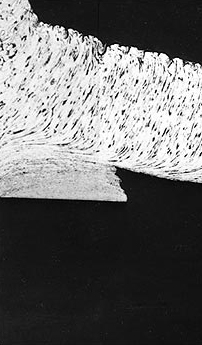4.3 The mechanics of machining
During any machining operation, the cutting tool comes in contact with the material to be cut, called the workpiece. The cutting machine has to hold both the tool and workpiece, and to move one relative to the other for the cutting operation to be performed.
All cutting processes are essentially complex arrangements of a simple single-point cutting operation: a saw blade is just a collection of single-point cutting tools; sandpaper is lots of single-point cutting grits stuck onto a piece of paper.
When the cutting tool is brought into contact with the workpiece, it detaches a thin layer of unwanted material (the 'chip'). Figure 42 shows the relative position of tool and workpiece during a machining operation. The tip of the tool is shaped like a wedge so that the faces of the tool are always inclined to the machined surface of the workpiece in order to limit the area of rubbing between tool and workpiece. This rubbing is undesirable because it wastes energy and it causes the tool to wear at an increased rate.
In deforming the chip, work is done by the tool on the workpiece and more than 90 per cent of this energy is transformed into heat. This heat is concentrated in a small volume of the workpiece near the tip of the tool. The actual temperature profile near the cutting point depends on the thermal and mechanical properties of both the tool and workpiece but it is common for temperatures to reach 700°C locally, even when liquid coolants are used.
At these temperatures, a state of partial seizure or bonding exists at the tool/workpiece interface, as the chip starts to weld to the tool. This is highly undesirable, since it contributes both to wear of the tool and to the consumption of energy during machining. Lubrication does help relieve the situation, but the careful design of the cutting tool is of paramount importance. There are specific tool geometries and cutting angles for different materials which help to keep temperatures and energies to a minimum while they are being cut.
The main attraction of machining as a shaping process is its ability to produce almost any shape accurately. However, machining requires expensive capital equipment and can also produce a lot of waste material, and for large production volumes it often proves more expensive than alternative methods of shaping.
As we see from the above, there are two materials involved in machining: one is the tool and the other the workpiece. During machining, the material of the workpiece should deform plastically (or 'flow') while that of the tool remains rigid. So the tool material must be much harder (measured in terms of Hardness) and stronger than the workpiece at the temperatures that exist near the tip of the tool. Also, the tool should be stable at the cutting temperature; it should not oxidise or undergo microstructural changes which may decrease the strength of the tool. Wear of the tool is inevitable under machining conditions, but by using material that has a high wear resistance, tool life is maximised.

